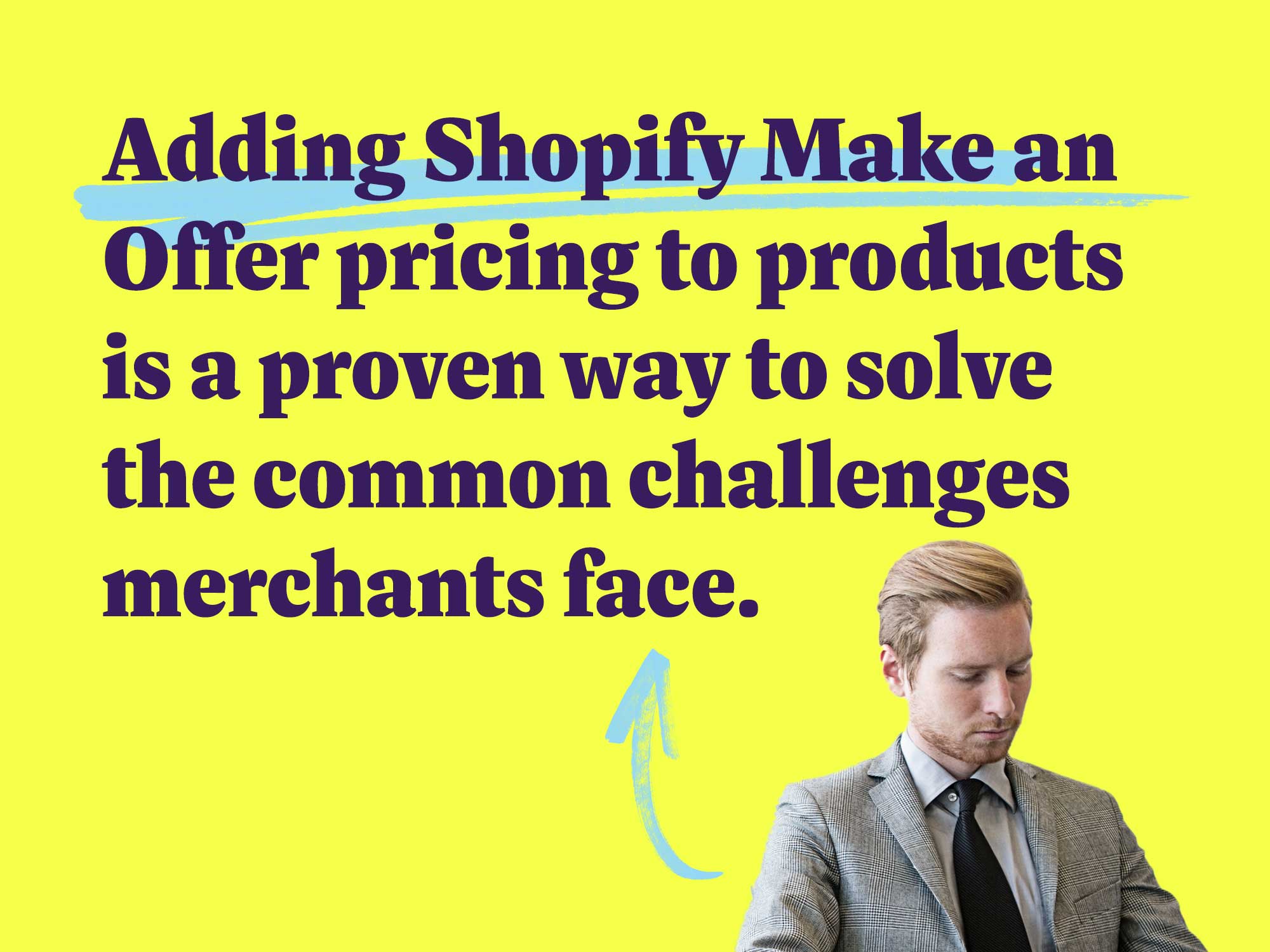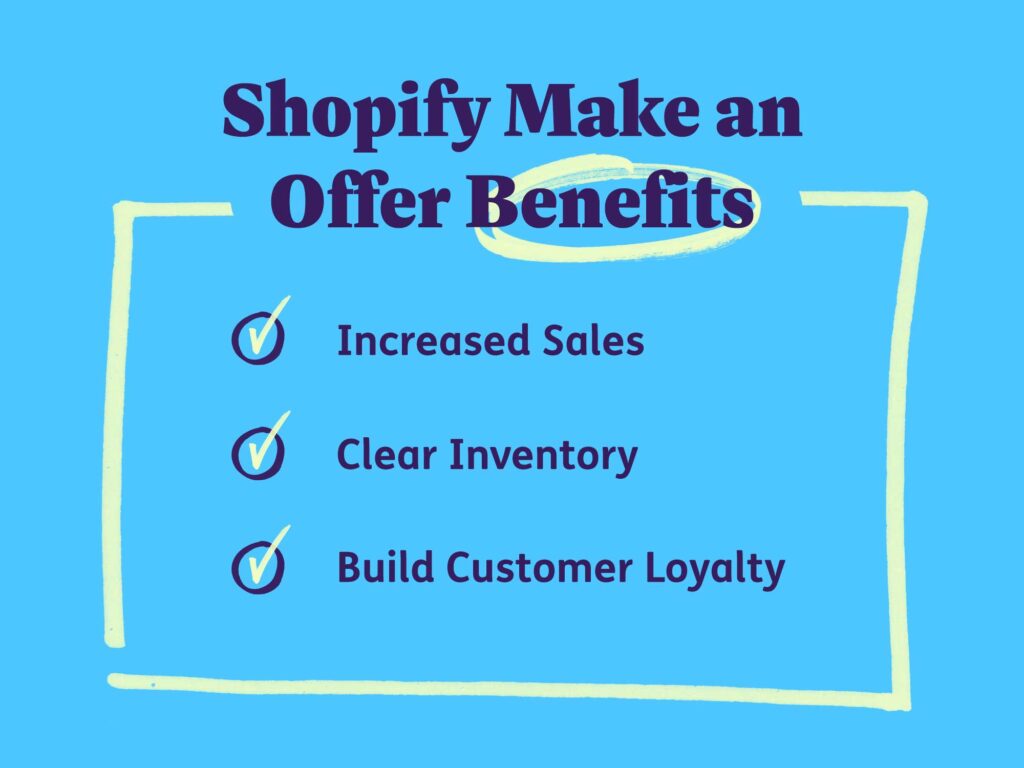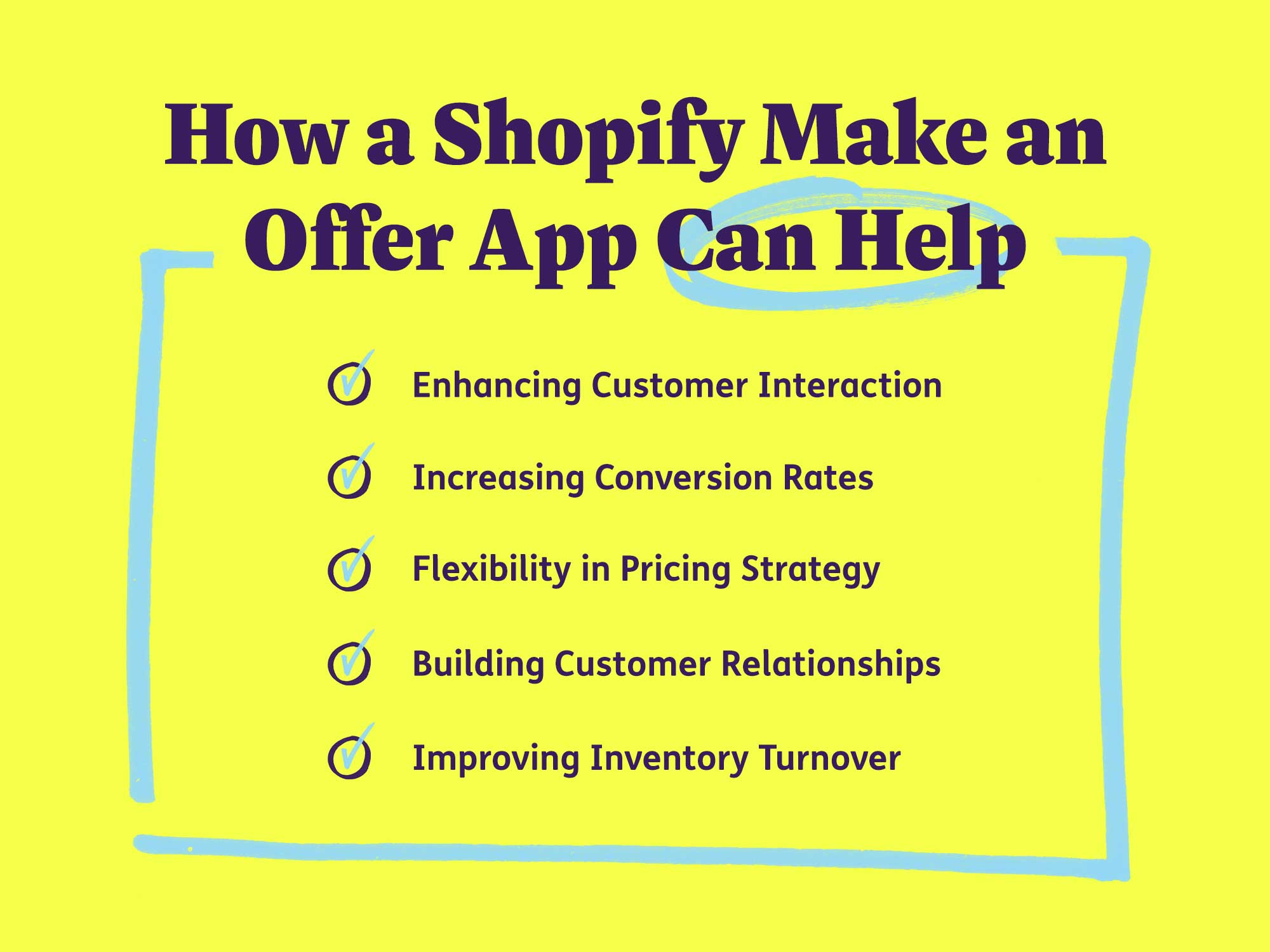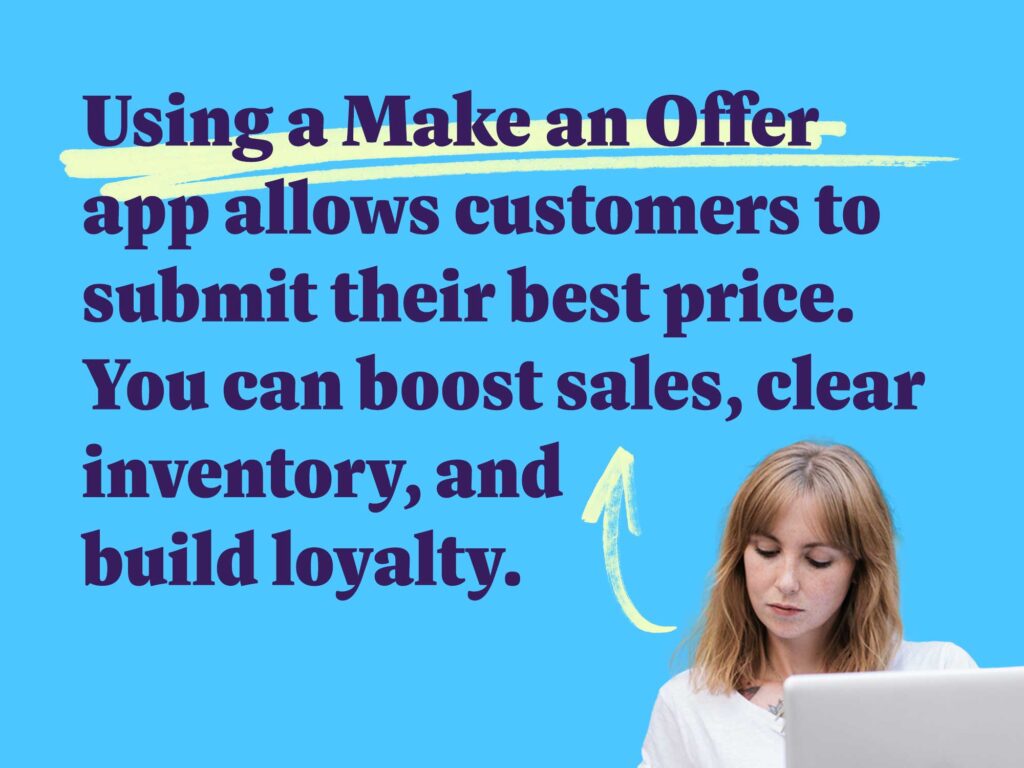Shopify merchants feel it everyday. Pressure from their competitors and the e-commerce landscape as a whole. Increase sales. Engage with customers. Their to-do list never ends. And they wonder, “Am I doing everything right?”.
These are a few of the common challenges every Shopify merchant faces. I know this because I spoke directly to 48 of them. In these conversations, my goal was to uncover their pain points in selling online. As the customer lead at Magical Apps, it’s my job to know how I can help Shopify merchants. I wanted to determine how I could do that.
In this article, you will hear from both Shopify merchants and the experts who serve them. I first reveal the challenges Shopify merchants face in detail. Then, I outline how a solution like a Shopify Make an Offer app can play a big role driving the growth they seek.
Common Challenges Faced by Shopify Merchants
1. Inventory Management and Acquisition
Managing inventory and sourcing high-quality products are significant challenges for many Shopify merchants.
It’s a common issue I encountered while calling stores, especially those in the antiques and collectibles world. Ensuring a steady supply of desirable items can be both time-consuming and expensive.
Here’s what some merchants had to say:
- “Getting good stuff is the hard part…” – Paul Madden Antiques
- “Sourcing quality products takes time and effort.” – Biordi
- “We struggle with finding reliable suppliers.” – Erie Basin
- “Maintaining inventory levels can be challenging.” – Sam’s Collectibles
- “Finding new suppliers is always a task.” – Old Time Finds
- “We constantly search for unique items.” – Vintage Haven
- “Keeping our inventory stocked is a major task.” – Antique Treasures
- “Sourcing high-quality antiques is difficult.” – Antique World
- “Our inventory turnover is crucial.” – Curated Finds
2. Balancing Online and In-Store Sales
Balancing online and in-store sales is a challenge many merchants face. From my conversations, it became clear that while in-store sales provide a tactile shopping experience, an online presence is essential for reaching a broader audience.
Most merchants gave me the impression that in an ideal world, they would have a higher ratio of online sales to in-store sales.
Here are some insights from merchants:
- “Selling online for 2 years, in-store is still primary…” – Cape Fear Collectibles
- “Our in-store sales are strong, but we need to boost our online presence.” – Party Toyz
- “Managing both online and physical stores can be challenging.” – Erie Basin
- “Our online store complements our physical shop.” – Modern Treasures
- “We are working on improving our online sales.” – Antique Alley
- “The balance between online and in-store is crucial.” – Collector’s Corner
- “Both online and in-store sales are important to us.” – Gifts Galore
- “Our online presence needs to be stronger.” – Rare Finds
- “Balancing the two sales channels is a challenge.” – The Vintage Shop
3. Customer Engagement and Satisfaction
Engaging customers and ensuring their satisfaction are critical for the success of any business. Many merchants highlighted the importance of maintaining strong customer relationships both online and offline.
From my discussions, I found that although store owners might prefer to negotiate face-to-face, they know a large proportion of customers prefer to negotiate online.
Here’s what they shared:
- “Likes selling in-store, but online presence is crucial…” – Erie Basin
- “We enjoy face-to-face interactions, but our website needs more traffic.” – Biordi
- “Customer satisfaction is key, both online and offline.” – Paul Madden Antiques
- “Engaging customers online is a challenge.” – Retro Revival
- “We strive for excellent customer service.” – Gemstone Gallery
- “Building customer relationships is essential.” – Timeless Trinkets
- “Customer satisfaction drives our business.” – Antique Dreams
- “Maintaining strong customer relations is vital.” – Vintage Elegance
- “We value every customer interaction.” – Antique Emporium
4. Marketing and Promotion
Keeping up with digital marketing trends and effectively promoting products online can be daunting for many small businesses.
I’ve helped hundreds of small businesses over the last 10 years who felt overwhelmed and frustrated by the difficulty of finding new customers online. Merchants expressed the need for better marketing strategies during our conversations:
- “It’s hard to keep up with digital marketing trends.” – Cape Fear Collectibles
- “We need better ways to promote our products online.” – Party Toyz
- “Advertising costs can be prohibitive for small businesses.” – Biordi
- “Online advertising is expensive.” – Antique Junction
- “We are looking for affordable marketing options.” – Curio Shop
- “Promoting our store online is a challenge.” – Vintage Vault
- “Marketing strategies need constant updating.” – Collector’s Corner
- “Digital marketing trends evolve quickly.” – Classic Collectibles
- “We need cost-effective promotion methods.” – Retro Relics
5. Managing Discounts and Offers
Offering discounts and managing special offers effectively can attract customers but also pose challenges in maintaining profitability.
Many stores told me that rising expenses like increasing shipping costs make it harder to run sales and promos.
Here’s what merchants had to say about this issue:
- “Offering discounts is tricky; we want to attract customers but still make a profit.” – Paul Madden Antiques
- “Sales events help, but we need more dynamic pricing strategies.” – Cape Fear Collectibles
- “We’re looking for ways to negotiate prices without devaluing our products.” – Party Toyz
- “Managing discounts effectively is a challenge.” – Collector’s Haven
- “We need better pricing strategies.” – Classic Finds
- “Offering discounts can be a double-edged sword.” – Heritage Antiques
- “We must balance discounts and profits.” – Retro Treasures
- “Negotiating offers can boost sales.” – Antique Discoveries
- “Effective discount management is crucial.” – Vintage Vault

How Make an Offer Works
A Make an Offer app is a simple way to allow customers to submit their best offer for a product. The app includes a button on the product page, or in a popup modal window, that encourages users to Make an Offer. Customers can enter the amount they would like to offer for the item. The merchant then has the option to accept, decline, or counter the offer. If the offer is accepted, the customer can purchase the item at the agreed-upon price.
Now that you know how the feature functions, let’s look at the key ways it helps Shopify merchants improve sales and loyalty
Key Benefits of Make an Offer
Increased Sales
By allowing customers to make an offer, you can capture sales that may have otherwise been lost due to price sensitivity. Customers who may have been hesitant to purchase at full price may be more willing to buy if they can negotiate a lower price.
Clear Inventory
A “Make an Offer” app can be a useful tool for clearing out inventory that is not moving as quickly as you would like. By accepting lower offers, you can move products that may have otherwise sat on your shelves.
Build Customer Loyalty
By giving customers the ability to negotiate a price, you are showing that you value their business and are willing to work with them. This can lead to increased customer loyalty and repeat business.

How Shopify Merchants Say a Make an Offer App Can Help
1. Enhancing Customer Interaction
The Make an Offer app allows customers to propose prices for products, creating a more interactive shopping experience.
This feature can be particularly beneficial for stores looking to engage customers directly in the pricing process. Personally, I prefer to ask for a better price online rather than face-to-face, so I can empathize with customers who prefer to shop this way. From my discussions, I found that merchants value this interactive approach:
- “Having a direct way for customers to negotiate prices could rejuvenate interest from long-time patrons and attract new customers.” – Biordi
- “Customers appreciate having a say in the price.” – Erie Basin
- “This app can make our sales process more engaging.” – Paul Madden Antiques
- “Interactive pricing can boost customer engagement.” – Old Time Finds
- “Customers like being involved in the pricing process.” – Vintage Haven
- “This app makes pricing more dynamic.” – Retro Revival
- “Customers love negotiating prices.” – Antique Alley
- “Engaging customers with offers builds loyalty.” – Modern Treasures
- “Negotiating prices enhances customer interaction.” – The Vintage Shop
2. Increasing Conversion Rates
By enabling customers to negotiate prices, merchants can convert hesitant buyers into paying customers.
This flexibility can significantly boost conversion rates. Merchants told me time and time again that the perfect deal can fall through the cracks if the price isn’t right for their customers:
- “We like selling online when we can because we’re able to reach a wider audience…” – Party Toyz
- “Negotiation can turn window shoppers into buyers.” – Cape Fear Collectibles
- “Flexible pricing can boost our sales.” – Erie Basin
- “Negotiating prices helps close sales.” – Gemstone Gallery
- “Customers are more likely to buy when they can negotiate.” – Timeless Trinkets
- “This app can increase our conversion rates.” – Modern Treasures
- “Negotiation features help close more sales.” – Antique Treasures
- “Flexible pricing converts more visitors to buyers.” – Antique World
- “Dynamic pricing helps us sell more items.” – Curated Finds
- “The ability to negotiate prices leads to more purchases.” – Gifts Galore
- “Negotiations turn potential buyers into actual buyers.” – Rare Finds
3. Flexibility in Pricing Strategy
The app offers flexibility, allowing merchants to manage and respond to offers dynamically. This flexibility is crucial for adapting to market conditions and customer demands.
I recall hearing from some merchants that industries like precious metals experience price changes hourly, or sometimes within minutes!
Here’s what merchants had to say about flexible pricing:
- “The flexibility to respond to offers in real-time could streamline our online sales process and complement our in-store operations.” – Cape Fear Collectibles
- “We can tailor our pricing strategy more effectively.” – Paul Madden Antiques
- “Dynamic pricing helps us stay competitive.” – Party Toyz
- “Flexible pricing is a game-changer.” – Collector’s Haven
- “This app allows us to adjust prices on the fly.” – Classic Finds
- “Real-time price adjustments are crucial.” – Curio Shop
- “We can adapt prices to market trends quickly.” – Antique Junction
- “Being able to negotiate in real-time is invaluable.” – Vintage Vault
- “Flexible pricing strategies keep us competitive.” – Retro Relics
4. Building Customer Relationships
Engaging with customers through price negotiations can strengthen relationships and build loyalty.
Personally, when I feel like I’ve gotten a good deal at a particular vendor, I tend to have a more memorable shopping experience and am likely to return to that store. Merchants recognize the value of this personalized interaction, as I learned from our discussions:
- “Engaging with customers through offers builds loyalty.” – Erie Basin
- “Customers feel valued when we consider their price offers.” – Paul Madden Antiques
- “This app can strengthen our customer relationships.” – Biordi
- “Personalized pricing enhances customer loyalty.” – Retro Revival
- “Building customer relationships is key.” – Gemstone Gallery
- “This app helps us connect with customers.” – Timeless Trinkets
- “Customer negotiations build trust.” – Antique Dreams
- “Interacting with customers on price strengthens ties.” – Vintage Elegance
- “Negotiating prices makes customers feel appreciated.” – Antique Emporium
- “This app enhances customer relationships.” – Antique Treasures
When I feel like I’ve gotten a good deal at a particular vendor, I tend to have a more memorable shopping experience and am likely to return to that store.
5. Improving Inventory Turnover
I spoke with many merchants who normally refused to accept offers online, however most of them agreed that make an offer would actually help them to move stale inventory.
The Make an Offer app can help merchants manage their inventory more effectively by enabling them to negotiate prices for slow-moving stock. This can lead to improved inventory turnover.
Merchants shared their experiences with me:
- “Negotiation helps us move slow-selling inventory.” – Cape Fear Collectibles
- “We can clear out old stock more efficiently.” – Party Toyz
- “This app aids in managing our inventory better.” – Paul Madden Antiques
- “Clearing out inventory is easier with negotiations.” – Vintage Vault
- “We can reduce excess stock through offers.” – Antique Junction
- “Dynamic pricing helps clear out old items.” – Curio Shop
- “This app helps manage slow-moving products.” – Retro Relics
- “Inventory turnover improves with flexible pricing.” – Collector’s Haven
- “Negotiations help us move products faster.” – Classic Finds

Real Merchant Insights
Here’s what some merchants had to say about the potential impact of the Make an Offer app:
- “Having a direct way for customers to negotiate prices could rejuvenate interest from long-time patrons and attract new customers.” – Biordi
- “The flexibility to respond to offers in real-time could streamline our online sales process and complement our in-store operations.” – Cape Fear Collectibles
- “The Make an Offer app can enhance our sales strategy.” – Party Toyz
- “Customers love the negotiation feature.” – Erie Basin
- “This app could increase our online engagement.” – Paul Madden Antiques
- “Interactive pricing boosts customer interest.” – Sam’s Collectibles
- “Negotiations make our store more appealing.” – Old Time Finds
- “Customers enjoy the negotiation process.” – Vintage Haven
- “This app helps us connect with customers in new ways.” – Antique Treasures
- “The Make an Offer feature is a game-changer.” – Antique World
- “Negotiating prices improves our sales.” – Curated Finds
- “This app makes our pricing strategy more flexible.” – Gifts Galore
- “Real-time offers boost customer satisfaction.” – Rare Finds
- “Dynamic pricing helps us stay competitive.” – The Vintage Shop
- “The ability to negotiate prices is a great tool.” – Modern Treasures
- “Customers love making offers on products.” – Antique Alley
- “This app enhances our overall sales strategy.” – Retro Revival
- “Negotiating prices adds a personal touch.” – Gemstone Gallery
- “Customer relationships improve with negotiation.” – Timeless Trinkets
- “This app helps us clear out old stock effectively.” – Antique Dreams
- “Personalized pricing increases customer loyalty.” – Vintage Elegance
- “This app is great for managing inventory.” – Antique Emporium
Shopify Experts Weigh in on the Results
I spoke to a lot of different merchants and I wanted to get a little perspective from some e-commerce experts, too.
So I sourced some select feedback from a range of experts to see what they had to say about the common pain points and the potential impact of tools like a Make an Offer app.
Expert Opinion on Inventory Management and Acquisition
- “Products in high demand but limited supply benefit from higher prices. Obviously, this situation is good for retailers that can earn extra profits. These price increases also are healthy for the supply chain because they can slow demand growth so that networks can still function effectively while managing and warehousing fewer items.” Pini Mandel, Association for Supply Chain Management
- “By changing prices based on how much stock there is and how many people want to buy, businesses can avoid having too much leftover stock or running out of popular items. This makes sure they sell things quickly and don’t have to spend too much money storing things they can’t sell.” Joan Ngugi, Data Science, Strathmore University – iLabAfrica
- “The findings show that the online customer experience (measured as shopping environment, shopping procedure, staff service experience, and product experience) substantially influenced customer engagement, which improved customer loyalty.” – Farooq Ahmad et al., Online Customer Experience Leads to Loyalty via Customer Engagement
- “Including consumers in co-creating a delightful online customer experience from time to time may be a valuable strategy for online retailers to increase customer engagement and loyalty.” – Farooq Ahmad et al., Online Customer Experience Leads to Loyalty via Customer Engagement
Expert Opinion on Balancing Online and In-Store Sales
- “E-commerce represents about 7 percent of total retail sales, with a projected growth of about 10 percent every year, three times the rate of total retail sales.” Regis Chenavaz, KEDGE Business School, Marseille, France
- “As the costs for changing prices have been reduced dramatically by new technologies, the methodology of posted [or fixed] prices has become suboptimal.” Oliver Hinz, University of Frankfurt
- “Customer experience has steadily become the most important source of retailers’ long-term competitive advantage via difference.” – Farooq Ahmad et al., Online Customer Experience Leads to Loyalty via Customer Engagement
- “Most consumers now engage in a hybrid approach, where a single shopping experience involves both in-store and digital touchpoints. In fact, this hybrid retail journey is the primary buying method for 27% of all consumers” –IBM
Expert Opinion on Customer Engagement and Satisfaction
- “Consumers are now more empowered and informed, resulting in heightened price sensitivity and a greater demand for personalized pricing.” John Paul Suarez, World Citi Colleges – Quezon City
- “Dynamic pricing can enhance customer satisfaction by offering personalized pricing that aligns with individual customer behavior and preferences.” – Square
- “Dynamic pricing, also known as real-time pricing, has been widely adopted in many industries including airlines, car rental, hotel, and cruise…at least 22% of retailers, including Sears, Bestbuy, and Walmart, have chosen to implement automatic pricing solutions in their online channel and improve their gross margin by 10%” –Yanzhe Lei, Stephen M. Ross School of Business
- “Research indicates that consumers usually pay positive amounts and that PWYW pricing can increase firms’ turnover and profits.” –Weisstein, Kukar-Kinney, and Monroe, Journal of Business Research.
Expert Opinion on Marketing and Promotion
- “Dynamic pricing is based on real-time changes in supply and demand. It considers market price fluctuations and monitors competitor activity.” business.com
- “A decrease in the supply chain’s capacity or an increase in negotiation costs (both of which are typically considered as worsening the retailer’s business environment) translates into higher profit for the retailer.” –Chia-Wei Kuo. Department of Business Administration National Taiwan University
- “Dynamic pricing can help businesses remain competitive by quickly responding to market changes and customer demands, ensuring that prices reflect the current value perceived by customers.” – Square
- “Dynamic pricing is fast becoming a must-have capability to drive growth while sustaining margins.” – McKinsey
Expert Opinion on Managing Discounts and Offers
- “Dynamic pricing involves adjusting the price of a product or service in real time based on various factors such as demand, competition, and customer behavior. This strategy optimizes pricing for maximum revenue or profit by responding to predetermined inputs.” – Jenna Illies, Content Marketing Manager at Square
- “Dynamic pricing is fast becoming a must-have capability to drive growth while sustaining margins.” – McKinsey
- “Interactive pricing has been spreading more widely with the rise of Internet commerce, and this trend can be expected to continue.” Robert M. Schindler, Pricing Strategies: A Marketing Approach
- “…Higher-share brands tend to over-promote, while lower-share brands do not promote frequently enough. A more dynamic approach to pricing and promotion could improve profits by 7% to 31%” –Kopalle, Mela, and Marsh
These insights from industry experts highlight the importance of flexible and dynamic tools in addressing common e-commerce challenges. The Make an Offer app, with its interactive pricing and negotiation features, is well-positioned to help merchants enhance their operations and customer relationships.
Insights from Shopify App Experts
Lastly, I reached out to the founders of the top-rated Shopify app for best offers, Magical Make an Offer, to ask them three key questions about why the Make an Offer feature works so well for Shopify merchants.
1. Why do you think the Make an Offer feature resonates so well with both merchants and customers?
- “I’m actually a collector myself, and so I regularly go to flea markets and antique fairs myself… I love being able to negotiate with sellers and to find a deal that feels fair for everyone. It adds such a personal element to a purchase transaction.” – John Speed, Co-founder of Magical Apps
- “I search online used platforms for products and negotiating is pretty much expected when buying and selling used online. By adding our app, merchants create opportunities for direct communication and negotiation, which aren’t possible with standard “add to cart” or “buy now” buttons. This helps build relationships with their customers and hopefully repeat business.” – Stephen Smith, Co-founder of Magical Apps
- “Our app fundamentally transforms the online shopping experience by reintroducing the element of human interaction, which is often lost in the digital marketplace. This feature is not just a tool, but a bridge that connects merchants and customers in a more personal and engaging manner.” – Max Blamauer, Web Developer of Magical Apps
- “The Make an Offer feature brings some of the interactivity back into online shopping – bringing your best garage sale experience online! The back-and-forth exchange helps the merchant to sell through their inventory and leaves the customer feeling like they’ve gotten a great deal made just for them. Everybody wins!” – Jeff Chew, Senior Developer for Magical Apps
- “For merchants, the Make an Offer feature resonates because it boosts their sales and helps them to clear inventory that might not have otherwise sold. With an automated solution like a Shopify app, there’s no downside. For customers, the option resonates with them because it makes them feel like they can get a deal. But perhaps more importantly, it indicates that the company is willing to listen to them. The online e-commerce space is often devoid of direct human interaction. Adding Make an Offer as a purchase option brings it back. Not only does it enable direct negotiation, it also creates a relationship between the merchant and customer that can be nurtured over time. Overall, it’s a win-win for both sides.” – Scott Williamson, Product Lead at Magical Apps
2. How does the Make an Offer app help merchants manage their pricing strategies effectively?
- “Our app gives merchants the flexibility to accept, counter, or reject offers in real-time. So it takes a lot of the headache of negotiation off the plates of merchants. As a business owner myself I know how many things you need to juggle to run a successful business. Giving merchants tools that help them with dynamic pricing, helps them sell more products, and grow their business. Additionally, it allows for better inventory management by providing an easy way to clear out slow-moving stock without resorting to blanket discounts.” – John Speed, Co-founder of Magical Apps
- “Turning on Make an Offer for single products or groups of products gives merchants a quick and easy way to test pricing beyond sale pricing or discounts. Making products available for offer can give merchants feedback directly from customers about what they think the product is worth which they can use to adjust pricing in the future. “ – Stephen Smith, Co-founder of Magical Apps
- “Our app encourages merchants to contemplate the minimum and maximum amounts they’d accept for a product. This not only aids in strategizing for best and worst-case scenarios but also significantly accelerates product turnover.” – Max Blamauer, Web Developer of Magical Apps
- “The Make an Offer app allows merchants to create different offers for different products or groups of products; allowing them to create automations for accepting, countering, or declining offers that are in line with their desired profit margins. This allows them to move inventory dynamically while upholding their bottom line.” – Jeff Chew, Senior Developer for Magical Apps
- “The Make an Offer app enables merchants to set rules dictating what offers they will accept, decline, or counter. Automation can be applied to rules, making the negotiation process hands-off. Back-and-forth negotiation can be time consuming. Using automation can improve the efficiency of a merchant’s workflow. Merchants can also set multiple rules to target different products or collections. Customization and creation of additional rules allows merchants to set pricing policies tailored to the unique circumstances surrounding that product.” – Scott Williamson, Product Lead at Magical Apps
3. Can you share any success stories or metrics that highlight the impact of the Make an Offer app on merchants’ sales and customer relationships?
- “We’ve had numerous success stories where merchants saw significant increases in their conversion rates and customer satisfaction levels. One notable example is a merchant who reported a 30% increase in sales after implementing our app. He’s a luxury watch seller in Miami. I actually made him a low ball offer on a Rolex Milgauss but it was automatically declined. Haha. .” – John Speed, Co-founder of Magical Apps
- “One of our merchants specializes in selling auto parts, with a vast inventory of individual items at various price points. By utilizing our app, they don’t need to constantly monitor which parts are moving slowly or run frequent sales. Instead, they allow customers to make offers, review the offers when they have time and accept, decline or counter them. This approach has been incredibly effective, leading to over 30% of their sales being made through our app. “ – Stephen Smith, Co-founder of Magical Apps
- Many merchants have success using Make an Offer and since joining the company, I’ve quickly noticed that merchants are willing to engage in discussions about their product prices. Their primary goal is to ensure that customers are content with their purchases. This becomes particularly clear when merchants set their automatic acceptance rate at over half of the product’s original listed price. – Max Blamauer, Web Developer of Magical Apps
- “Not every product has an easy MSRP. The Make an Offer app is used by many merchants who sell rare collectables, for example trading cards. How do you put a solid price on something whose price tag has yellowed with time and fallen off? You don’t! You find that niche customer who has the same interests as you do and see what it’s worth to them! In that spirit I one-day hope to make an offer on the Magic card of my dreams and become part of the story myself.” – Jeff Chew, Senior Developer for Magical Apps
- “While the impact may vary from merchant to merchant, and industry to industry, some merchants have reported in five-star reviews of the Make an Offer app that it boosted their sales by 20% or more. With the increased flexibility offered by the Make an Offer feature, more customers are incentivized to engage with and purchase from your business.” – Scott Williamson, Product Lead at Magical Apps
These insights from the founders of Magical Make an Offer highlight the real experiences that our merchants and their customers have with using the Make an Offer feature in their stores. When buying preowned items, customers expect to be able to negotiate. By enabling make an offer features, you capture more sales, and your customers feel good about getting a good deal. It’s a win-win for everyone.
Talking to these Shopify merchants has given me a real sense of the common challenges they face in running their online stores.
From managing inventory to balancing online and in-store sales, engaging customers, keeping up with marketing trends, and handling discounts and offers, these pain points are shared by many. Hearing about these struggles first hand has been both eye-opening and insightful.
What really stood out in these conversations was how much flexibility and customer interaction can help. Many merchants found success with the Make an Offer app, which allows customers to propose prices and makes the shopping experience more engaging. It’s more than just a tool—it’s about connecting with customers and making their shopping experience better, which in turn can boost sales.
Small changes in how you interact with customers or manage pricing can make a big difference
In the past, I’ve spoken to merchants who were hesitant to implement this feature, thinking it wouldn’t work for their store. However, those who did work with us clearly saw an increase in sales and improved customer satisfaction. For Shopify stores, make an offer really does work.
If you’re facing similar challenges in your e-commerce journey, consider exploring tools and strategies that might help. Sometimes, small changes in how you interact with customers or manage pricing can make a big difference. The insights shared by these merchants have been incredibly valuable, and I hope they can help you find your own path to success.
Tips for Getting the Most Out of a “Make an Offer” App
Set a Reasonable Minimum Price
When setting up your “Make an Offer” app, be sure to set a minimum price that you are willing to accept. It’s possible to also set minimum price percentage based thresholds. This will prevent customers from submitting offers that are too low and wasting your time. It’s also important to be flexible with your pricing so that you are giving customers a legitimate chance to make a successful offer and allow them to pay what you want for the product.
Be Responsive to Your Offers
It’s important to stay on top of the offers you receive from customers. You can use the built in dashboard to track the success of your “Make an Offer” feature. Monitor the number of offers submitted, accepted, and declined, as well as the average price of accepted offers. Use this information to optimize your pricing strategy and make informed business decisions.
A best offer price negotiation app like Magical Make an Offer can be a valuable tool for any Shopify merchant looking to increase sales, clear inventory, and build customer loyalty. By following these tips and leveraging the benefits of a “Make an Offer” feature, you can take your business to the next level.

Magical Make an Offer
Use the Magical Make an Offer app to sell more products. Easily add Make an Offer and Pay What you Want buttons to products.
